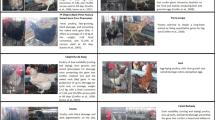Summary
-
1.
It is suggested that the genetic types of fleece structure found in different breeds of sheep are due to the interaction of the following developmental factors:
-
(a.)
The quantity of ‘fibre substrate’ available.
-
b)
Differences between various types of follicle in the efficiency with which they compete with one another for the available substrate. The efficiency of a follicle is closely related to its time of initiation.
-
(c)
Differences between breeds in the curve relating follicle-efficiency to time of initiation, (the ‘efficiency curve’).
-
d)
Differences between breeds in the density of fibres per unit area. Since the number of primary follicles per unit area seems to remain constant, the differences in density are caused by differences in the ratio of primary to secondary fibres.
-
2.
The factors (a) and (d) may be fairly simply evaluated, from the total weight of fleece formed, and from direct estimations of follicle density. The form of the efficiency curve may be deduced from an analysis of fibre-types in birthcoats (Fraser, 1951c). Using these values, it is possible to calculate theoretical fleece structures corresponding to various combinations of the basic developmental factors.
-
3.
A series of such theoretical fleece structures is calculated and compared with the genetic types known to characterize different breeds or varieties. The correspondence is usually good, but our present knowledge of fleece structure is too meagre to test the hypothesis adequately, since many of its detailed predictions cannot yet be checked with ascertained facts.
-
4.
It is suggested that in the evolution of breeds within the British Isles there first occurred a change in the efficiency curve, which converted the original carpet type into a longwool, and that this later evolved into the shortwool by a reduction in the available fibre substrate. The Merino type includes a great variety of efficiency curves (a point in Which the N-type differs from the normal) and the Merino characteristics seem to be due primarily to a high fibre density., I am grateful to Prof. C. H. Waddington for his assistance during the formulation of this concept and for revision of the manuscript. I would also like to express my appreciation for the assistance of Mr D. W. M. Pinkney and Mr E. D. Roberts in the preparation of the figures, and to Mr W. S. Russell for making the necessary computations. The work was completed while the author held a maintenance grant from the Agricultural Research Council.
Similar content being viewed by others
References
Bergen, W. V. &Mauersberger, H. R. (1948).The Wool Handbook. New York.
Carter, H. B. (1942). Fleece density and histology.J. Coun. Sci. Inclustr. Res. Aust. 15, 217.
Dry, F. W. (1934). Fibre types of the New Zealand Romney lamb.N.Z. J. Agric. 48, 331.
Dry, F. W. (1940). Biology of the Romney fleece.N.Z. J. Sci. Tech. 22, 200.
Fraser, A. S. (1951a). Competition between skin follicles in sheep.Nature, Land.,167, 202.
Fraser, A. S. (1951b). Studies on N-type sheep. (Unpublished.)
Fraser, A. S. (1951c). Growth of wool fibres in sheep. (Unpublished.)
Fraser, A. S. &Hamada, M. K. O. (1951). Comparisons between British breeds and crosses.Proc.Roy. Soc. Edinb. (in the Press).
Fraser, A. S.,Ross, J. M. &Wright, G. M. (1951). (Unpublished.)
Galpin, N. M. (1948). Wool growth.J. Agric. Sci. 37, 275.
Lang, W. R. (1950). Non-kenrpy medullated fibres in Australian wool.J. Text. Inst., Manchr,41, 309.
Author information
Authors and Affiliations
Rights and permissions
About this article
Cite this article
Fraser, A.S. Factors in the genetic determination of fleece structure in sheep. Journ. of Genetics 51, 222–236 (1953). https://doi.org/10.1007/BF03023294
Issue Date:
DOI: https://doi.org/10.1007/BF03023294



